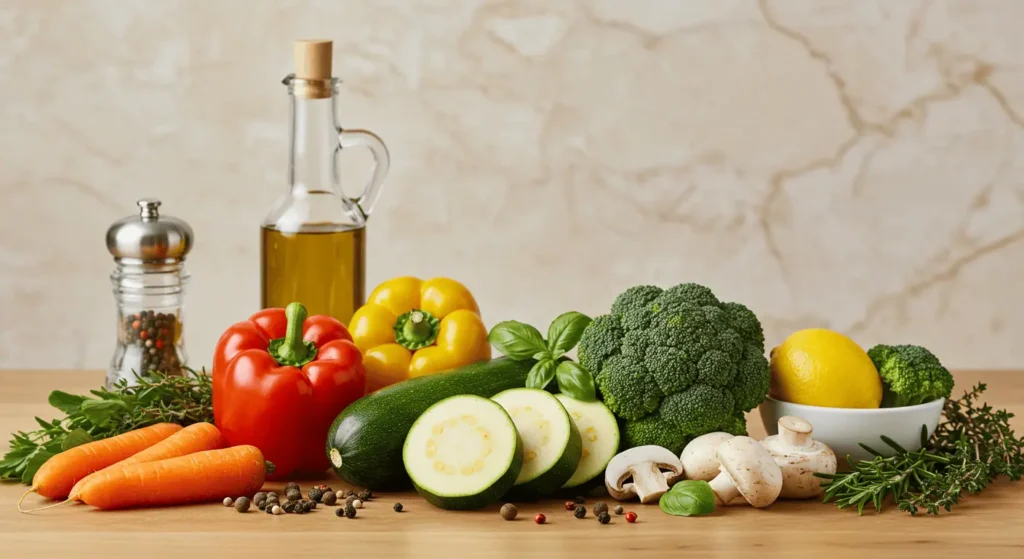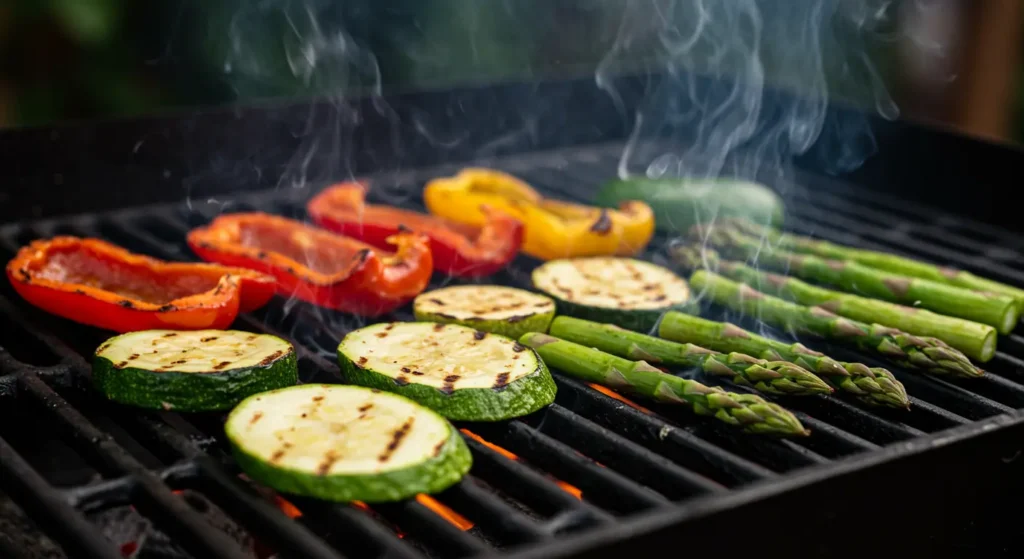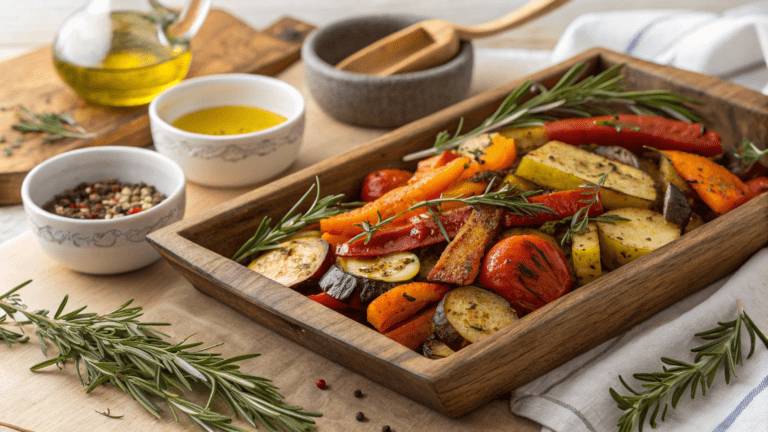10 Proven Ways to Enhance Vegetable Flavors Naturally
How to Enhance Vegetable Flavors Naturally ?
Table of Contents
Vegetables are packed with nutrients, but their flavors can sometimes be underwhelming. The good news is that you don’t need artificial additives to make them taste incredible. By using the right cooking techniques, natural seasonings, and umami-rich ingredients, you can enhance vegetable flavors naturally while keeping meals healthy and delicious.
In this guide, we explore ten proven methods to bring out the best in your vegetables.
The Science Behind Vegetable Flavors
To enhance vegetable flavors naturally, it’s important to understand the science behind how vegetables develop taste. Their flavors come from natural compounds that interact with heat, acidity, and fats during cooking. Mastering these elements allows you to elevate your dishes without artificial additives.
Key Natural Compounds Affecting Vegetable Taste
Vegetables contain unique compounds that contribute to their flavor profile:
- Glucosinolates – Found in cruciferous vegetables (like broccoli and Brussels sprouts), these compounds create a slightly bitter taste that can be mellowed through roasting or steaming.
- Sugars & Caramelization – Natural sugars in vegetables like carrots and onions intensify through roasting, leading to a deeper, richer sweetness. Try this quinoa salad with roasted veggies to see caramelization in action.
- Umami Compounds – Mushrooms, tomatoes, and seaweed contain glutamates, enhancing savory depth. Adding nutritional yeast or miso can further boost umami. Explore umami-rich recipes like this chicken and mushroom dish.
- Acidity & Brightness – Lemon juice, vinegar, and fermented foods cut through heaviness, bringing out freshness. Read more about natural acidic enhancers.
How Cooking Techniques Influence Flavor
The way you cook vegetables can enhance vegetable flavors naturally by intensifying or mellowing specific taste elements.
- Roasting – Brings out natural sweetness via caramelization. Learn more about roasting vegetables effectively.
- Grilling – Adds smoky depth and crisp texture. Try pairing grilled veggies with umami-rich flavors like those in this vegetable lasagna recipe.
- Steaming – Retains freshness and natural taste while softening bitterness.
- Fermentation – Adds complexity and tanginess. Explore fermented flavors in healthy salads for lunch.
By combining these cooking techniques with the right ingredients, you can enhance vegetable flavors naturally and create vibrant, flavorful meals.
Choosing Fresh, Seasonal Produce

To enhance vegetable flavors naturally, the first step is selecting the best-quality produce. Fresh, seasonal vegetables have superior taste, texture, and nutrient content compared to out-of-season or processed options.
Why Fresh & Seasonal Vegetables Taste Better
- Higher Natural Sugar Content – Vegetables harvested at peak ripeness contain more natural sugars, making them naturally sweeter and more flavorful.
- Better Texture & Aroma – Fresh vegetables retain their crispness and fragrance, enhancing the eating experience.
- Fewer Preservatives & Transport Impact – Local, seasonal vegetables don’t undergo long storage or artificial ripening processes, ensuring they taste fresh and vibrant.
How to Source High-Quality Produce
To maximize flavor, choose fresh, high-quality vegetables by following these tips:
- Visit Farmers’ Markets – Buying directly from farmers ensures freshness and seasonal variety.
- Grow Your Own – Even small herb gardens can dramatically improve the taste of home-cooked meals.
- Check for Ripeness – Look for vibrant colors, firm textures, and a natural aroma. Avoid dull or wilted produce.
- Choose Organic When Possible – Pesticide-free vegetables often have a purer, more intense flavor.
For ideas on how to incorporate fresh produce into flavorful meals, explore healthy and fresh recipes.ay, see this guide to enhancing vegetable flavors naturally.
Cooking Methods That Elevate Natural Flavors
One of the best ways to enhance vegetable flavors naturally is by using the right cooking methods. Techniques such as roasting, grilling, steaming, and sautéing can unlock deeper, richer tastes while preserving nutrients and textures.
Each cooking method influences flavor in a unique way, transforming simple vegetables into mouthwatering dishes. Let’s explore how these methods can elevate your vegetable game.
Roasting for Richness

Roasting is one of the most effective ways to enhance vegetable flavors naturally. It brings out natural sweetness by caramelizing sugars and creating a crispy, golden-brown texture.
🔥 How Roasting Works
- When exposed to high heat, vegetables release natural sugars, which brown and develop a deeper, richer flavor.
- The dry heat also removes excess moisture, concentrating the taste.
🥕 Best Vegetables for Roasting:
- Carrots, sweet potatoes, and squash (bring out their natural sweetness)
- Cauliflower and Brussels sprouts (develop crispy edges)
- Bell peppers and cherry tomatoes (enhance juiciness and depth)
👩🍳 Pro Tip: Toss your vegetables in olive oil, sprinkle with salt and your favorite herbs, and roast at 400°F (200°C) for 20-30 minutes. For a real flavor boost, add a splash of balsamic vinegar.
👉 Try this in action with this quinoa salad with roasted veggies.
Grilling for a Smoky Depth

Grilling is an excellent technique to enhance vegetable flavors naturally, infusing them with a smoky aroma and a charred, slightly crispy texture.
🔥 Why Grilling Works:
- The direct high heat caramelizes sugars quickly, intensifying the flavor.
- The smoky char adds a depth that other cooking methods can’t replicate.
🍆 Best Vegetables for Grilling:
- Zucchini, eggplant, and asparagus (hold up well to high heat)
- Bell peppers and mushrooms (develop a rich, deep flavor)
- Corn on the cob (smoky-sweet balance)
👨🍳 Grilling Technique:
- Brush vegetables lightly with olive oil and season with salt.
- Use a medium-high heat setting on the grill (or a grill pan).
- Flip once to ensure even charring.
👉 For a delicious grilled vegetable dish, check out this vegetable lasagna recipe.
Steaming for Retaining Pure Flavors
Steaming is the ideal method if you want to enhance vegetable flavors naturally while keeping them crisp, vibrant, and nutrient-dense.
🔥 Why Steaming Works:
- Preserves Nutrients – Unlike boiling, which leaches vitamins into water, steaming keeps nutrients intact.
- Maintains Freshness – Vegetables stay crisp and colorful rather than becoming soggy.
🥦 Best Vegetables for Steaming:
- Broccoli, green beans, and spinach (retain a bright green color)
- Carrots and beets (preserve natural sweetness)
- Cauliflower and zucchini (hold firm without getting mushy)
👩🍳 Steaming Technique:
- Bring 1-2 inches of water to a boil in a pot.
- Place vegetables in a steamer basket above the water.
- Cover and steam for 5-10 minutes, depending on the vegetable.
✨ Enhancing Steamed Vegetables:
After steaming, drizzle with:
✅ Lemon juice for acidity and brightness.
✅ Olive oil and garlic for richness.
✅ Nutritional yeast for a savory, umami boost.
👉 For more ideas on how to bring out fresh vegetable flavors, try these healthy salads for lunch.
Mastering Cooking Techniques for Maximum Flavor
By choosing the right cooking method, you can enhance vegetable flavors naturally without relying on artificial ingredients. Whether roasting for richness, grilling for smoky intensity, or steaming for fresh vibrancy, each technique adds its own unique depth.
Experiment with these methods in your kitchen and explore Fabilous Taste for even more flavorful vegetable recipes!
Here’s your detailed expansion of “The Role of Natural Fats in Flavor Enhancement” and “The Magic of Spices and Herbs”, with a focus on “Enhance Vegetable Flavors Naturally” and integrated internal links for SEO and added value.
The Role of Natural Fats in Flavor Enhancement

One of the best ways to enhance vegetable flavors naturally is by incorporating natural fats like olive oil, butter, and avocado oil. Fats carry and amplify flavors, improve texture, and help with nutrient absorption.
Why Fats Make Vegetables Taste Better
- Enhance Aroma – Fat dissolves flavor compounds, helping aromatic ingredients like garlic and herbs spread more evenly.
- Improve Texture – Adds richness, crispiness (when roasting or sautéing), and creaminess (when blending into soups or dressings).
- Increase Nutrient Absorption – Vitamins A, D, E, and K are fat-soluble, meaning your body absorbs them better when eaten with healthy fats.
Best Natural Fats for Flavorful Vegetables
🫒 Olive Oil – A staple in Mediterranean cooking, it adds a smooth, slightly peppery depth to vegetables. Try it drizzled over roasted Brussels sprouts.
🧈 Butter (or Ghee) – Adds richness and enhances the natural sweetness of carrots, green beans, and corn.
🥑 Avocado Oil – With a high smoke point, it’s great for high-heat roasting and grilling.
🥜 Nut Oils (Almond, Walnut, Sesame) – Add nutty undertones, perfect for roasted squash or Asian-inspired vegetable dishes.
How to Use Natural Fats to Maximize Flavor
✅ Roasting: Toss vegetables in olive oil before roasting to lock in moisture and caramelize their sugars.
✅ Sautéing: Use butter or ghee to add richness to mushrooms and leafy greens.
✅ Drizzling: A final drizzle of truffle oil or sesame oil can intensify depth and aroma.
👉 For a dish that balances healthy fats and umami, try this chicken and mushroom recipe.
The Magic of Spices and Herbs
To enhance vegetable flavors naturally, one of the most effective techniques is using spices and herbs. The right seasoning can transform bland vegetables into flavorful, exciting dishes.
🌿 Herbs provide freshness, while
🌶 Spices add warmth, depth, and complexity.
Best Herb & Spice Pairings for Vegetables
🥕 Carrots: Cinnamon, cumin, or thyme to bring out their natural sweetness.
🥦 Broccoli: Garlic, lemon zest, and red pepper flakes for a zesty kick.
🥔 Potatoes: Rosemary, black pepper, and smoked paprika for depth.
🍆 Eggplant: Oregano, basil, and coriander for Mediterranean flair.
🌽 Corn: Chili powder and lime for a bold, smoky taste.
Fresh vs. Dried Herbs – When to Use Them
One way to enhance vegetable flavors naturally is by knowing when to use fresh vs. dried herbs.
✅ Fresh Herbs:
- Best for finishing dishes, as their delicate flavors fade when cooked for too long.
- Ideal for salads, raw dishes, and adding brightness at the end of cooking.
- Examples: Basil, cilantro, chives, dill, parsley.
✅ Dried Herbs:
- Best for slow-cooked dishes where their concentrated flavors develop over time.
- More potent than fresh herbs, so use ½ teaspoon of dried for every 1 teaspoon of fresh.
- Examples: Thyme, oregano, rosemary, sage.
👉 To see fresh herbs in action, try this sundried tomato pasta recipe.
Spice Combinations for Maximum Impact
Pairing the right spices can enhance vegetable flavors naturally by creating depth and balance. Here are some tried-and-true blends:
🔥 Middle Eastern Blend (Great for Roasted Veggies)
- Cumin + Coriander + Paprika + Cinnamon
🌿 Mediterranean Blend (Perfect for Grilled Vegetables)
- Oregano + Thyme + Garlic Powder + Lemon Zest
🌶 Mexican Blend (Ideal for Corn & Beans)
- Chili Powder + Smoked Paprika + Cumin + Lime Juice
🍛 Indian Blend (Delicious with Lentils & Root Vegetables)
- Turmeric + Garam Masala + Mustard Seeds
For more flavorful spice blends, check out delicious vegetable recipes.
Natural Acidic Enhancers for Brightness
One of the easiest ways to enhance vegetable flavors naturally is by adding acidity. Acids brighten flavors, balance sweetness, and cut through bitterness, making vegetables taste fresher and more vibrant.
How Acidity Enhances Vegetable Flavors
Acidic ingredients interact with vegetables by:
✔️ Balancing flavors – They reduce bitterness in cruciferous vegetables like kale and Brussels sprouts.
✔️ Highlighting sweetness – They bring out natural sugars in roasted carrots, beets, and squash.
✔️ Adding freshness – A touch of acidity makes dishes feel lighter and more flavorful.
Best Natural Acidic Ingredients
🍋 Lemon & Citrus Juice – Adds a bright, zesty note to both raw and cooked vegetables.
🍎 Vinegar (Balsamic, Apple Cider, Red Wine, Rice Vinegar) – Boosts depth and enhances caramelized flavors.
🥒 Fermented Ingredients (Kimchi, Pickles, Sauerkraut, Yogurt) – Create tanginess and complexity.
How to Use Acidity to Maximize Flavor
✅ Lemon & Lime Juice – Squeeze over steamed broccoli, asparagus, or avocado to keep them fresh and zesty.
✅ Balsamic Vinegar – Drizzle over roasted Brussels sprouts or mushrooms for a caramelized depth.
✅ Apple Cider Vinegar – Toss with cucumbers, red onions, or cabbage for a light, refreshing salad.
✅ Fermented Ingredients – Add a spoonful of sauerkraut or kimchi to roasted vegetables for a tangy umami kick.
👉 For an example of how acidity enhances flavors, check out this sundried tomato pasta recipe.
Umami Boosters for a Deeper Taste Profile
To enhance vegetable flavors naturally, adding umami-rich ingredients is key. Umami—the “fifth taste”—creates depth, richness, and a savory complexity that makes vegetables more satisfying.
What Is Umami?
Umami is the deep, savory taste found in fermented and aged foods. It intensifies flavors without overpowering them, making vegetables taste heartier and more robust.
Best Umami-Rich Ingredients for Vegetables
🍄 Mushrooms – Packed with natural glutamates, they add a meaty richness to vegetable dishes.
🍜 Miso Paste – A fermented soybean paste that enhances broths, glazes, and dressings.
🧀 Nutritional Yeast – Adds a cheesy, nutty depth without dairy.
🥫 Tomato Paste & Sun-Dried Tomatoes – Intensify the savory profile of sauces and stews.
🫘 Soy Sauce & Tamari – Provide deep umami and saltiness to sautéed greens and stir-fries.
How to Use Umami Boosters to Elevate Flavor
✅ Sauté mushrooms with garlic and olive oil for a rich side dish.
✅ Stir miso paste into soups or dressings for extra depth.
✅ Sprinkle nutritional yeast over roasted cauliflower or popcorn for a cheesy flavor.
✅ Mix tomato paste into sauces and stews to enhance umami.
👉 For a dish rich in umami flavors, try this chicken and mushroom recipe.
The Importance of Proper Seasoning
One of the most fundamental ways to enhance vegetable flavors naturally is through proper seasoning. Salt, pepper, and mineral balance help bring out the best in vegetables, creating depth and complexity without overpowering their natural taste.
Why Seasoning Matters
✔️ Enhances natural flavors – Salt amplifies the natural sweetness of roasted vegetables.
✔️ Balances bitterness and acidity – A pinch of salt or sugar can reduce harsh bitterness in greens like kale or Brussels sprouts.
✔️ Adds depth and contrast – A combination of salt, pepper, and acidity makes flavors more dynamic.
Essential Seasonings for Vegetables
🧂 Salt: The most important seasoning! It enhances natural flavors and balances bitterness. Use sea salt or kosher salt for better texture.
🌶 Black Pepper: Adds mild heat and complexity. Freshly ground pepper provides the best flavor.
🌿 Herbs & Spices: Thyme, cumin, smoked paprika, and coriander add unique notes.
🍋 Acidity (Lemon, Vinegar): Helps brighten flavors and cut through richness.
How to Season Vegetables for Maximum Flavor
✅ Salt Before & After Cooking: Lightly season raw vegetables, then add a final sprinkle before serving.
✅ Layering Flavors: Combine salt with umami boosters like miso or soy sauce for a richer taste.
✅ Use Smoked or Flavored Salts: Smoked sea salt or truffle salt can add depth and complexity.
👉 For a well-seasoned vegetable dish, try this roasted vegetable quinoa salad.
Fermentation for Complex Flavors

Fermentation is an ancient technique that enhances vegetable flavors naturally by adding depth, tanginess, and umami. Foods like kimchi, pickles, sauerkraut, and miso create complex flavors while improving digestion and gut health.
How Fermentation Enhances Vegetable Dishes
✔️ Adds Tanginess & Depth – Fermented foods provide a balance of acidity, sweetness, and umami.
✔️ Boosts Natural Umami – Miso, kimchi, and soy-based ferments intensify flavors without extra salt.
✔️ Enhances Nutrient Absorption – Fermented vegetables contain probiotics that support gut health.
Best Fermented Ingredients to Boost Vegetable Dishes
🥒 Pickles & Sauerkraut – Add a crunchy, tangy contrast to roasted and fresh vegetables.
🌶 Kimchi – A spicy, umami-rich ingredient perfect for stir-fries and grain bowls.
🍜 Miso Paste – Great for soups, marinades, and salad dressings.
🍷 Fermented Vinegars (Apple Cider, Red Wine, Rice Vinegar) – Bring acidity and brightness to roasted vegetables.
How to Use Fermented Foods in Vegetable Dishes
✅ Top roasted vegetables with kimchi for a bold, spicy kick.
✅ Mix sauerkraut into salads for an extra layer of tanginess.
✅ Stir miso paste into vegetable-based soups to deepen the umami profile.
✅ Use fermented vinegars in dressings and marinades to brighten flavors.
👉 For a dish that highlights fermented ingredients, check out this healthy salad recipe.
Here’s your detailed expansion of “The Art of Layering Flavors,” “FAQs,” and “Conclusion,” with a focus on “Enhance Vegetable Flavors Naturally” and integrated internal links for SEO and added value.
The Art of Layering Flavors

To enhance vegetable flavors naturally, mastering the art of layering flavors is essential. Combining multiple techniques—such as roasting, seasoning, acidity, umami boosters, and healthy fats—creates depth and richness in every bite.
What Is Flavor Layering?
Layering flavors means building taste step by step by using different cooking methods, seasonings, and textures. The result is a balanced and dynamic dish that tastes more complex and satisfying.
How to Layer Flavors for Maximum Impact
1️⃣ Start with Fresh Ingredients – Choose seasonal, high-quality vegetables for the best natural taste. Learn how to pick the freshest produce in this seasonal vegetable guide.
2️⃣ Use a Cooking Technique That Enhances Flavor – Roast, grill, or steam vegetables to bring out their natural sweetness or smokiness. Try roasting for depth or grilling for bold flavors.
3️⃣ Incorporate Natural Fats – Olive oil, butter, and nut oils help carry and amplify flavors. Toss steamed greens with garlic-infused olive oil for richness.
4️⃣ Balance with Acidity – A splash of lemon juice or balsamic vinegar brightens flavors and cuts through heaviness. Learn more about acidic enhancers.
5️⃣ Add an Umami Boost – Miso, mushrooms, and nutritional yeast add depth and savoriness. Explore umami-rich recipes like this mushroom dish.
6️⃣ Finish with Fresh Herbs & Spices – Sprinkle fresh basil, thyme, or smoked paprika just before serving to intensify aroma and taste.
✨ Example:
For a layered, flavorful dish, try roasting carrots with olive oil, adding a splash of balsamic vinegar, then finishing with fresh parsley and toasted almonds.
FAQs: Answering Common Questions About Enhancing Vegetable Flavors
1. How can I make vegetables taste better without butter or oil?
You can enhance vegetable flavors naturally by using roasting, grilling, or steaming techniques combined with:
- Acidic ingredients (lemon juice, vinegar)
- Herbs & spices (garlic, smoked paprika, cumin)
- Umami boosters (miso, soy sauce, nutritional yeast)
👉 Try using this sundried tomato recipe to bring out flavors without added fats.
2. Why do some vegetables taste bitter, and how can I fix it?
Bitterness is common in Brussels sprouts, kale, and eggplant. To balance bitterness:
✔ Roast or sauté to caramelize natural sugars.
✔ Add salt & acidity (lemon juice, vinegar) to counteract harsh flavors.
✔ Pair with umami ingredients like mushrooms or parmesan.
3. What are the best herbs and spices to use with vegetables?
🌱 Herbs: Basil, thyme, rosemary, parsley (for freshness)
🌶 Spices: Smoked paprika, cumin, turmeric, chili powder (for depth)
4. Can fermentation really improve vegetable flavors?
Yes! Kimchi, sauerkraut, and pickles add tangy, umami-rich complexity. Fermentation also improves digestion and nutrient absorption.
👉 Try adding fermented foods to your vegetable dishes.
Conclusion: Mastering the Art of Flavorful Vegetables
To enhance vegetable flavors naturally, use a combination of:
✔ Proper cooking techniques (roasting, grilling, steaming)
✔ Seasoning balance (salt, spices, herbs, acidity)
✔ Umami boosters (miso, mushrooms, soy sauce)
✔ Healthy fats (olive oil, avocado oil, butter)
✔ Fermentation for complexity (kimchi, pickles, miso)
By layering flavors and using natural enhancers, you can transform simple vegetables into delicious, restaurant-quality dishes.
For more inspiration, visit Fabilous Taste for recipes, cooking tips, and expert advice.


1 thought on “Enhance Vegetable Flavors Naturally”
Comments are closed.